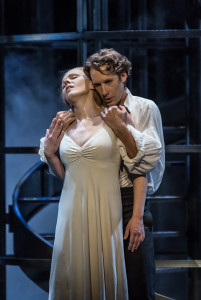The statement is often made that Debussy’s Pelléas et Mélisande is among one of the most influential operas in history and the Welsh National Opera certainly paid homage to that. The striking visual imagery of the skeletal tower was the first thing that caught my eye and set the precedent for the tone of the show summed up succinctly as; a hauntingly beautiful tale of the torment love can bring.
Jurgita Adamonyte and Jacques Imbrailo
Debussy’s work can often be referred to as ‘impressionistic’, although Debussy rejected this label. Debussy was clearly moved and taken with the new movement in the art world and the impressionistic music was clearly evident throughout the performance in which structure is subordinate to harmony. However, in particular with the characterisation of Mélisande, who at times did not seem real; rather, elusive and magical. It is like she is an impression of a person rather than a person herself. In the scene of Mélisande letting down her hair from the tower whilst Pelléas basks in her abundant locks familiar to the story of Rapunzel; was impressionist art in it’s purest form. The moving imagery of the hair swaying across Pelléas envisaged in my mind the shifting effect of light and bold colour often seen in the visual impression of the art from that era.
Jacques Imbrailo and Chrsitopher Purves
The key element of water was extremely atmospheric and was used as symoblism throughout the performance. Once described as the abyss then again as miraculous waters, where Mélisande loses her wedding ring. It symbolises where the creation of the love between Golaud and Melisandre began and also where the destruction of that love took place, beginning with Mélisande losing her wedding ring.
Death was a constant theme talked about from the very beginning and as a symbolic metaphor in the lives of the main characters whose destinies are preordained from the beginning. Death is the worry on Mélisande’s mind when she begins to fall for Pelléas , she can feel the stench of death building to ultimately tragic consequences.
Outstanding performance from Christopher Purves who took on the formidable Golaud, whose fear, anger and paranoia grew in each scene and was played with an intensity derived from the loss of his wife and his determination to protect the childlike Mélisande.
The waif like and innocence projected by Jurgita Adamonyte as Mélisande, beautifully embodied the character who becomes caught up in the love triangle unintentionally, however very much aware of the tragedy looming if she stays in the castle with Golaud. Pelléas played by Jacques Imbrailo perfectly embodied the doomed lover similar to Shakespeare’s Romeo who is overcome with the beauty and love he has for Mélisande.
Jurgita Adamonyte and Rebecca Bottone
Pelléas and Mélisande can be seen as a mystical fairy tale with the character of Mélisande who casts her love spell on Goluad and Pelléas; thus creating the age-old love triangle, yet this Opera is so much more than that. This symbolic production captures the heart of the impressionist era and looks at the torturous theme of love controlling ones actions with no time for reflection until the aftermath. Credit to the combined efforts of the cast which was marvellously performed and atmospherically evoked by Lothar Koenigs conduction of Debussy’s only opera. Also the stunning work of Director David Pountney and the simplistic yet effective work of the set designer Johan Engles; ensured that this was a spellbinding performance of an opera with timeless themes that will captivate audiences.
Pelléas and Mélisande, Wales Millennium Centre, Cardiff , May 30th, June 4 & 6.



Comments